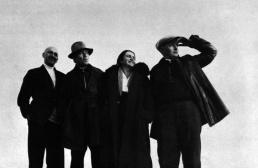Difference between revisions of "Sophie Lissitzky-Küppers"
Sorindanut (talk | contribs) |
|||
| Line 1: | Line 1: | ||
| − | '''Sophie | + | {{Infobox artist |
| − | She was | + | |image = Sophie_Lissitzky-Kueppers_1932.jpg |
| + | |imagesize = 250px | ||
| + | |caption = Sophie Lissitzky-Küppers, 1932. | ||
| + | |birth_date = {{birth date|1891|11|1|mf=y}} | ||
| + | |birth_place = Kiel, Germany | ||
| + | |death_date = {{Death date and age|1978|12|10|1891|11|1|mf=y}} | ||
| + | |death_place = Novosibirsk, USSR | ||
| + | }} | ||
| + | [[Image:Ruwim_Lissitzky_El_Lissitzky_Sophie_Lissitzky-Kueppers_Dziga_Vertov_in_Chodnja_1932.jpg|thumb|258px|Ruwim Lissitzky, El Lissitzky, Sophie Lissitzky-Küppers and [[Dziga Vertov]] in Chodnja, 1932.]] | ||
| + | [[Image:Sophie_Lissitzky-Kueppers_c1930.jpg|thumb|258px|Sophie Lissitzky-Küppers, c1930.]] | ||
| + | '''Sophie Küppers''' (1891–1978), born Sophie Schneider, was an art historian, patron of the avant-garde, author and art collector. | ||
| + | |||
| + | She was married to Paul Erich Küppers, the founding director of the Kestner Gesellschaft [Kestner Society] in Hanover (1916), who died of the Spanish flu in January 1922. She kept working as the artistic director of the Society; in January 1927 she moved to the Soviet Union and married the Russian artist, architect and designer [[El Lissitzky]], collaborating with him on a number of large-scale exhibition projects. | ||
| + | |||
| + | In 1944, three years after Lissitzky died, she was deported as enemy foreigner to Novosibirsk, where she continued to live under difficult conditions. Her son Jen tries to restitute paintings (by Klee, Kandinsky and others), which she left in Germany, and which were later sold to collectors and museums after being marked as ''Entartete Kunst'' in 1937 by the Nazis. | ||
==Literature== | ==Literature== | ||
| − | * '' | + | * Sophie Lissitzky-Küppers, "Die ersten Jahre", in ''Wegbereiter zur modernen Kunst. 50 Jahre Kestner-Gesellschaft'', ed. W. Schmied, 1966, pp 11-26. (in German) |
| − | + | * Sophie Lissitzky-Küppers (ed.), ''El Lissitzky: Maler, Architekt, Typograf, Fotograf, Errinerungen, Briefe Schirften'', Dresden: VEB Verlag der Kunst, 1967, 407 pp; 4th Edition, 1992. (in German) | |
| + | * Ingeborg Prior, ''Die geraubten Bilder. Die abenteuerliche Geschichte der Sophie Lissitzky-Küppers und ihrer Kunstsammlung'', Cologne: Kiepenheuer & Witsch, 2002. (in German) | ||
| + | * Hugo Thielen, [http://books.google.com/books?id=ShneE5mxmEUC&pg=PA216 "Sophie Küppers"], in ''Hannoversches Biographisches Lexikon'', Hanover, 2002, p 216. (in German) | ||
| − | == | + | ==External links== |
| − | * [http://de.wikipedia.org/wiki/Sophie_Lissitzky-K%C3%BCppers Sophie Küppers | + | * [http://de.wikipedia.org/wiki/Sophie_Lissitzky-K%C3%BCppers Sophie Küppers at German Wikipedia] |
Revision as of 02:38, 30 December 2013
 Sophie Lissitzky-Küppers, 1932. | |
| Born |
November 1, 1891 Kiel, Germany |
|---|---|
| Died |
December 10, 1978 (aged 87) Novosibirsk, USSR |

Sophie Küppers (1891–1978), born Sophie Schneider, was an art historian, patron of the avant-garde, author and art collector.
She was married to Paul Erich Küppers, the founding director of the Kestner Gesellschaft [Kestner Society] in Hanover (1916), who died of the Spanish flu in January 1922. She kept working as the artistic director of the Society; in January 1927 she moved to the Soviet Union and married the Russian artist, architect and designer El Lissitzky, collaborating with him on a number of large-scale exhibition projects.
In 1944, three years after Lissitzky died, she was deported as enemy foreigner to Novosibirsk, where she continued to live under difficult conditions. Her son Jen tries to restitute paintings (by Klee, Kandinsky and others), which she left in Germany, and which were later sold to collectors and museums after being marked as Entartete Kunst in 1937 by the Nazis.
Literature
- Sophie Lissitzky-Küppers, "Die ersten Jahre", in Wegbereiter zur modernen Kunst. 50 Jahre Kestner-Gesellschaft, ed. W. Schmied, 1966, pp 11-26. (in German)
- Sophie Lissitzky-Küppers (ed.), El Lissitzky: Maler, Architekt, Typograf, Fotograf, Errinerungen, Briefe Schirften, Dresden: VEB Verlag der Kunst, 1967, 407 pp; 4th Edition, 1992. (in German)
- Ingeborg Prior, Die geraubten Bilder. Die abenteuerliche Geschichte der Sophie Lissitzky-Küppers und ihrer Kunstsammlung, Cologne: Kiepenheuer & Witsch, 2002. (in German)
- Hugo Thielen, "Sophie Küppers", in Hannoversches Biographisches Lexikon, Hanover, 2002, p 216. (in German)
